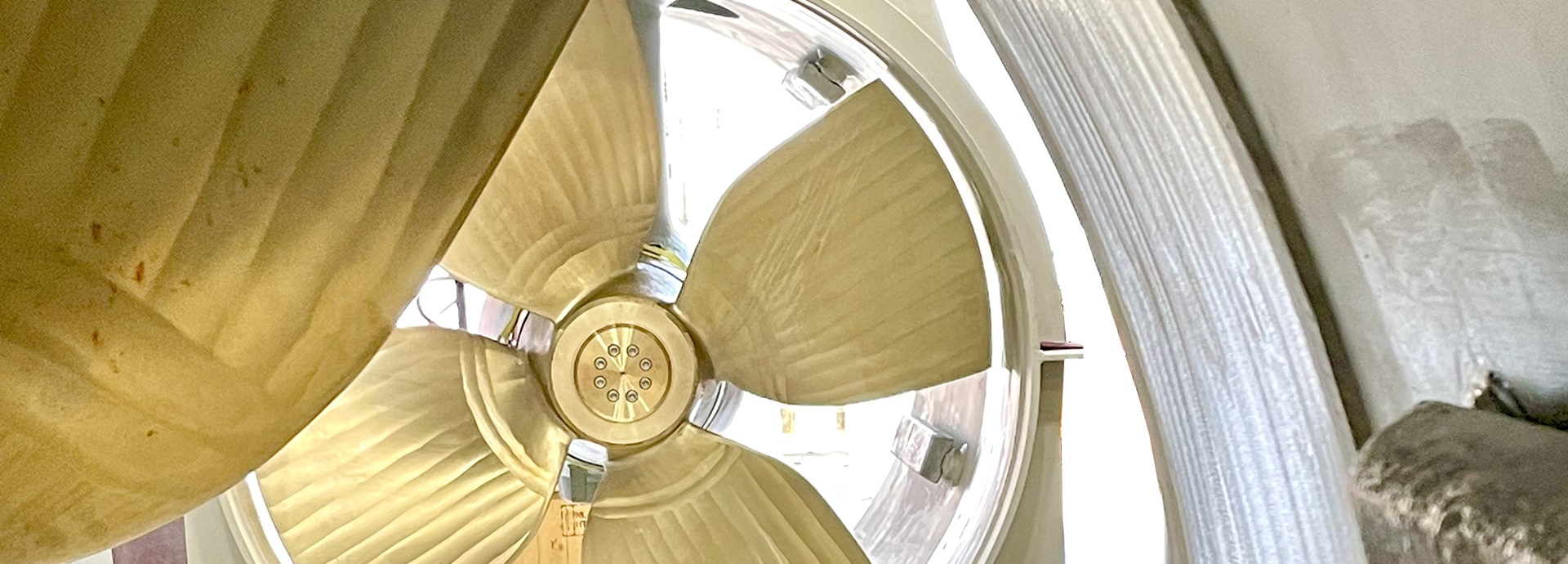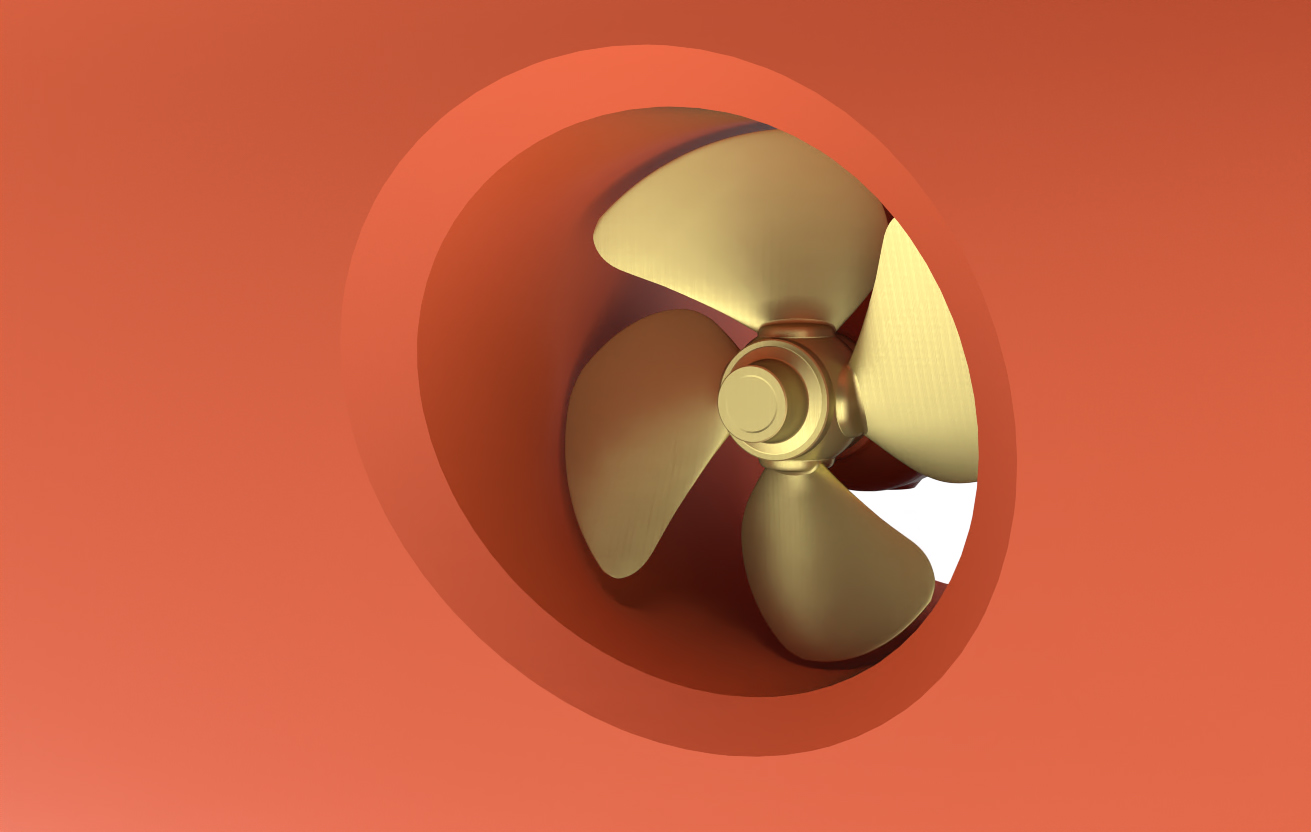

Sometimes buying the cheapest product makes good business sense. More often it’s a false economy. Bow thrusters are often seen as an off-the-shelf product where the cheapest option wins – but a recent study says otherwise. Could these surprising facts make your vessel more efficient and save you money in the process?
Vessel efficiency is a top priority for owners and operators thanks to decarbonisation pressures, rising fuel costs and increasingly strict regulations. An efficient vessel costs less to run and contributes to decarbonisation. It’s common to spend time carefully choosing engines and main propulsion equipment with efficiency in mind. Auxiliary thrusters for manoeuvring, however, are often viewed as a commodity, which is a risky misconception. These three facts show how the right bow thruster can save you money in the long run.
1. The right bow thruster will save energy
Thrusters go by many different names: you might know them as tunnel thrusters or transverse thrusters, for example. But whichever name is used, it’s typical for ship designers to choose the cheapest off-the-shelf model – which tends to be a controllable pitch propeller (CPP) with a constant speed drive. However, while a fixed pitch propeller (FPP) with variable speed drive might be more expensive, it will often cost you less overall, with a lower total cost of ownership.
When the operational conditions call for the thruster to be used at part or low loads, an FPP can reduce your fuel usage during manoeuvring by as much as 10–20% depending on how you use it. Thruster running hours on RoRo vessels can be as high as 4,000 hours a year so using 10% less fuel at low loads adds up to big savings. An FPP will also cut vessel emissions, which can help with meeting current and upcoming legislation. FPP units also tend to be easier to maintain, so you get more uptime. The payback time for choosing an FPP over a CPP is less than eight years, with a corresponding 15% CO2 reduction. Alternatively, if it suits your operational needs better, an 1800 kW FPP solution can produce around 8% more thrust, allowing faster vessel turnaround times.
Why choose an FPP thruster?
low-load manoeuvring
extra investment
2. The right bow thruster will minimise vessel resistance
The thruster’s tunnel openings create parasitic drag, especially when the ship is sailing and the thruster is not being used. In fact, tunnel openings account for 1% of overall vessel resistance. This might sound like nothing, but even 1% less drag can have a huge impact on how much fuel your vessel uses and therefore the amount of emissions it produces. Let’s look at an example. A study by Wärtsilä estimates that for container vessels ranging from 2,500–20,000 TEU, reducing the drag from tunnel openings by 5% (a 0.05% improvement in vessel resistance) will save €10,000–22,000 in annual fuel costs.
A standard tunnel opening might look something like this:

Drag can be minimised by:
- rounding the tunnel edges

- using scallops to guide the water flow aft of the tunnel

- adding grids to minimise water flow through the tunnel

These solutions all cost money to implement, but they save you money in the long term by reducing drag during normal ship operation. Optimising the tunnel design to reduce drag is not an option if you’re buying an off-the-shelf product at the last minute. To benefit from these easy to achieve fuel savings, it’s important to work with the OEM early in the vessel design phase.
3. The right bow thruster will save time in port
One key element of optimising operational efficiency is reducing the amount of time a ship spends in port. Increasing manoeuvrability means less time in port, so you can sail at slower speeds while keeping to the same schedule. This increases efficiency and reduces fuel costs. The benefit for RoRo vessels and ferries is clear; what is less often recognised is the significant savings available for other merchant vessels.
Impressive results were seen in a study carried out by Wärtsilä on how efficient manoeuvring contributes to total cost of ownership for container vessels. The study showed that a minor reduction in ship speed leads to significant fuel savings. Increasing the thrust capacity of bow thrusters and thereby improving manoeuvring can reduce time in port by 0.6 hours – for container vessels with three port calls in China and three in Europe, this allows sailing speeds to go down by 0.1 knots (e.g., from 20 to 19.9 knots) while still maintaining the schedule. The fuel saving for a 0.1 knot speed decrease is from 0.8 to 2.5 million euros for container vessels ranging in size from 2500–20,000 TEU. Taking the time to choose the right stern thruster early in the design process is an easy win, with savings to be realised on every journey your vessel undertakes.
How to choose the right manoeuvring thruster?
When choosing a thruster, start from your vessel’s operational profile. Ask yourself:
How you can optimise your vessel’s operation?
Which thruster gives you the lowest total cost of ownership?
It’s also important to choose a thruster that’s reliable and robust, ideally one that has been proven in the field for many years and can maintain performance over time. Bow thrusters are subject to extreme conditions and need to work safely and reliably with minimal maintenance to maximise uptime. For example, Wärtsilä has thrusters delivered over 30 years ago that are still in operation.
Consider getting support in thruster selection from the OEM – manoeuvring thrusters should not be seen as mere commodities but as an integral part of what your vessel needs to operate. Working with the OEM ensures you can have the right solution for your vessel with the option of an extended warranty and training if needed, saving you time and money in the long run. In order to optimise whole vessel operation you should get in touch with the OEM as early in the design process as possible for the best possible results.
Shipyards also benefit from the right thruster selection
Both owners and shipyards can benefit from Wärtsilä’s standardised design and delivery model for transverse thrusters. For owners of merchant vessels, a standardised product portfolio carefully tuned to the needs of the market is available, making selection easier. Because Wärtsilä thrusters have less cabling, they are simpler and cheaper for shipyards to install – as well as being more reliable for owners. Everything that can be preinstalled is, including the hydraulic system and any lubrication system, and the thruster comes with clear and detailed installation documentation. All this makes the installation as quick and easy as possible and ensures it can be handled by the shipyard without external assistance. For shipyards in China, our state-of-the-art propulsion manufacturing and competence centre in Wuxi is close at hand, and we can give quick answers to technical questions in the local language. Wherever your shipyard is based, our experts are ready to help – just get in touch with your local representative.
How much can you save?
The right thruster will save you energy, minimise drag and save you time in port, even with a low number of operational hours. Taking the time to choose the optimal thruster can significantly lower your total cost of ownership and increase the efficiency of your vessel. The optimal solution will also be quicker, cheaper and simpler for shipyards to install. An expert partner can help you to evaluate your options, optimise performance and make all the difference to your long-term bottom line. Taking time with Wärtsilä early in the design process is one of the best ways to ensure you achieve these benefits for your vessel.
Want to increase efficiency and lower lifetime costs by choosing the right bow thruster for your vessel? Get in touch to achieve just that.
Related solutions
Did you like this? Subscribe to Insights updates!
Once every six weeks, you will get the top picks – the latest and the greatest pieces – from this Insights channel by email.




